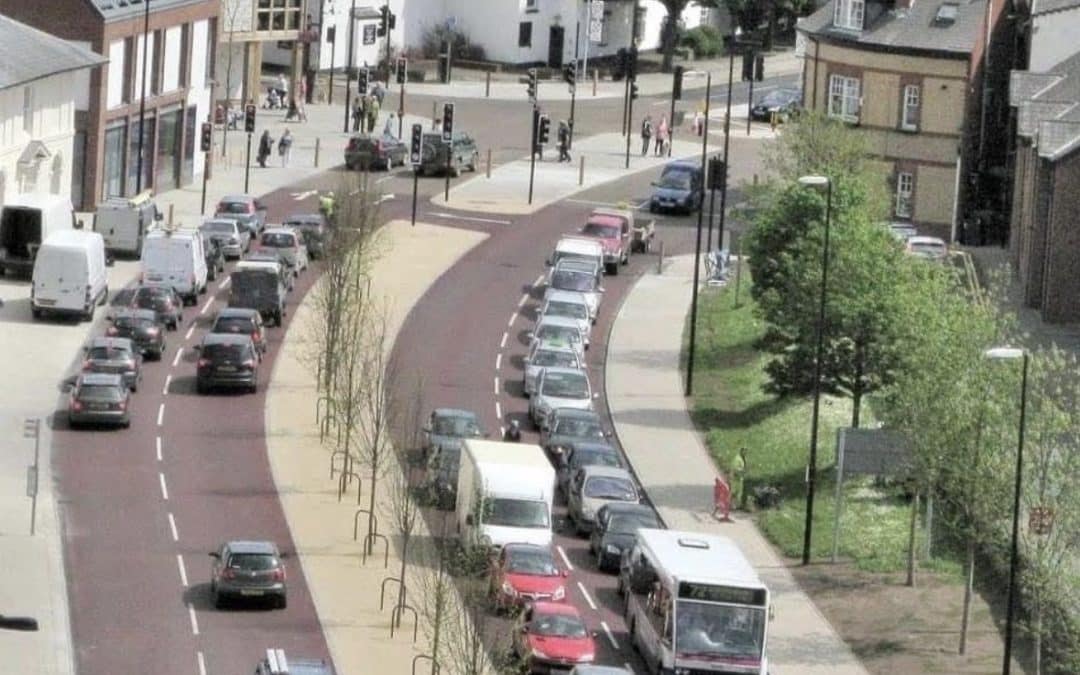Photo – Richard Williams
Herefordshire Council’s proposed County Plan for 2025-2041 shows plans for ‘bus only access’ and ‘bus priority’ on a number of streets in the county.
Plans to improve bus services in the county include:
Improving access to bus stops, including crossing facilities and cycle parking
Improving bus stop infrastructure, waiting facilities and safety, including bus time information, lighting, Wi-Fi and CCTV.
Providing bus priority and/or bus only access on certain streets to make bus services faster and more reliable.
Tackling delays caused by on street parking. For example, Cantilupe Road, Gloucester Road and the High Street in Ross-on-Wye.
Integrate bus times with the opening hours of leisure and social facilities and events.
Our aspiration is for half hourly service frequency between our Market Towns and Hereford City.
The priority will be services from Ross-on-Wye and Leominster, which are those with the largest population and anticipated new development.
Leominster is accessible from a wide rural hinterland with bus and rail services to Kington, Hereford City and the wider county available.
As trains cross at Leominster, it offers potential to provide bus to rail interchange. We will work with partners to redevelop the station forecourt, expand parking and improve interchange.
This will enhance the attractiveness of the station and further enhance its role as a public transport hub for the town and surrounding areas.
Colwall, Leominster and Ledbury railway stations provide 2 to 3 trains an hour to Hereford city and direct services to larger settlements.
Improving pedestrian access to these railway stations, including better crossings facilities and signage to town centres and key services is a priority for us to make rail a more feasible choice.
Community transport can also play a key role in improving access in rural areas where other transport services may not be commercially viable.
There are several existing voluntary community transport organisations operating buses and/or car club vehicles.
We will continue to support these operators and reduce barriers to introducing new services.
As the offer of community transport evolves, it will allow more of our people to benefit from these services in a quick, convenient and accessible way.
These rural challenges occur within the backdrop of uncertainty about future funding, changing technology and changing travel patterns.
The development of a Rural Mobility Strategy which explores how new and existing transport modes can be best delivered to meet the needs of our residents, businesses and visitors will be essential in supporting this.
This will provide a valuable tool for understanding where we prioritise investment and to identify interventions which will create the best benefit for people that live, work and visit Herefordshire.
Hereford city is likely to be the focus of growth and include new housing and employment.
New development will require significant transport infrastructure investment in the city and surrounding area to unlock growth.
The priorities to support this growth could include:
Delivery of a new vehicular route to the west of the city, providing access for new development areas and helping to take traffic away from the city centre.
Enhancements to city centre urban realm to improve attractiveness and boost the local and visitor economy.
Enhanced cycling, walking and wheeling facilities across the city, providing attractive facilities to maximise the number of short distance trips within Hereford city that are made by active travel.
With areas of flood plain to the east of Hereford, any new development is likely to be delivered to the north, south and west of city. New infrastructure including vehicular routes will be essential for providing access for all users and mitigating the impact of new travel demand on the historic city centre.
The exact alignment of a new route to the west of the city and connecting the A49 south of Hereford to the A49 in the north will be linked to the positioning of new development.
A new highway route travelling around the west will also help to take traffic away from the city centre and across the River Wye.
This will unlock a number of new opportunities to enhance the city centre. Reduced traffic and congestion will help to improve air quality.
It will also enable improvements to public realm in the city centre.
This could include more public space for people to spend time and dwell and more space for outside seating for food and drink premises.
This will create a more vibrant and attractive local area and in turn help to boost local business.
The new routes taking traffic out of the city centre and along the A49 will help to enable faster and more reliable bus journey times, and scope to provide dedicated bus priority. In turn this will support the viability of the city and interurban bus services to our Market Towns.
It will also create more opportunities to provide dedicated facilities for people to cycle, walk and wheel in the city centre.
Further improvements to sustainable travel options would also help to increase accessibility to employment sites and support the high-tech industries within the Enterprise Zone.
The focus of these will be bus service and active travel infrastructure, although subject to what development is proposed to the south of the city this could also include the potential for a new railway station.
There are a number of existing Park and Cycle/Change sites that increase choice and capacity for travel into the city.
We will explore the potential for new developments to provide more Park and Change sites on key corridors, such as the A49.
City centre parking is spread between a number of small car parks. Coupled with high demand to park in certain city centre car parks or streets, vehicular traffic circulation for car parking spaces is common and adds to local congestion.
Consolidation of off-street parking into a smaller number of larger sites could help to reduce vehicular traffic and release land for other uses.
We will draw on work on the Merton Meadows multi storey car park and develop a new Car Parking Strategy and proposals to improve car park signage for the city.
Enabling healthy behaviours and improving wellbeing.
The city benefits from a number of attractive routes for walking, wheeling and cycling. In addition to an attractive city centre pedestrian environment, routes include the Great Western Way from the south west towards the city centre and those along the riverside.
Recent improvements have further built upon this including Active Travel Fund schemes, pedestrianisation of streets and 20mph speed limits on many of the city centre shopping streets.
Around 40% of commuting trips in Hereford city are under 2km and 70% under 5km.
Approximately half of those trips under 2km are undertaken by car.
Improving facilities for walking, wheeling and cycling represents the most efficient means of shifting short distance trips in Hereford city out of the car.
Our aim is to make cycling, wheeling and walking the first travel choice for our residents of Hereford city.
This is matched by an aspiration of at least 50% of trips being made by walking, wheeling and cycling by 2041, at the latest.
This will be achieved by:
Delivering connected, comprehensive and safe walking, wheeling and cycling routes across the whole city.
Ensuring high quality cycling, wheeling and walking facilities from areas of new development into the city and joining to existing active travel networks
Expanding the number of low traffic streets and/or 20mph zones across the city centre and residential areas.
Connecting surrounding rural settlements to Hereford city, including by extending the riverside active travel network.
Expanding the on-street bike hire scheme in the city.
We will also look to increase the provision of secure cycle parking stands, for standard and non-standard bikes, at key destinations around the city centre and at our key interchanges such as the rail and bus station in Hereford city.
Delivering complete cycling, walking and wheeling routes will encourage more people to choose sustainable modes of travel for their everyday journeys.
This will reduce reliance on car but also have wider benefits for health, air quality and productivity.
These ambitions align to the approach that will be set out in our emerging Herefordshire Local Cycling Walking and Wheeling Infrastructure Plan (LCWWIP).
An overview of the priority measures for delivery are shown in the Figure 10, and listed in the Hereford City Action Plan. These will form the basis to develop a pipeline of active travel schemes for the city.
More Details – https://www.herefordshire.gov.uk/downloads/file/27372/herefordshire-draft-local-transport-plan

